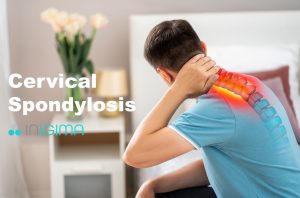Cervical Spondylitis: Cause Symptoms and Guideline

When the ligaments, bones, cartilage, and joints in your neck start to deteriorate with or without aging, it can lead to cervical spondylitis.
Spondylosis and cervical spondylitis were once thought to be symptoms of advanced age.
However, due to the current generation and way of life, spondylitis and spondylosis are not just a problem for older people.
How do you define cervical spondylitis?
The terms cervical osteoarthritis and degenerative osteoarthritis are also used to describe cervical spondylitis or spondylosis. The symptoms worsen with aging and passage of time. Cervical spondylitis may make even walking difficult if not properly and promptly treated.
Elderly people are more likely to develop cervical spondylosis. Our bones and ligaments start to weaken with advancing age. Neck pain and stiffness are symptoms of cervical spondylosis. Fluid loss results from the neck disc’s gradual degeneration. The discs start to rub against one another as a result of the fluid loss lead to cervical pain and stiffness. Osteophytes or spurs, which are abnormal growths, develop in the neck bones as a result of the discs’ continued deterioration and fluid loss.
Symptoms
- Cervical spondylosis symptoms can include:
- Neck discomfort that could radiate to your shoulders or arms
- Headaches
- Whenever you move your neck, it hurts.
- Your arms and legs are weak.
- Your hands, arms, or shoulders become numb
- Stiffness in the neck
- Difficulty maintaining balance
- Having issues with bowel or bladder control
Risk factors or complications
There are numerous risk factors for spondylosis, including:
Spinal stenosis
Spinal stenosis can develop if cervical spondylosis is not treated for an extended period of time. When the spinal canal narrows, a painful condition known as spinal stenosis or cervical myelopathy develops. If the spinal cord steadily narrows, it may suffer significant damage. A tingling sensation that may extend to your legs may be felt in your neck, arms, and shoulders. In extreme circumstances, you can also have trouble coordinating your movements. Lumbar spondylosis can result from cervical spondylitis as well.
Nerve compression
During the course of cervical spondylosis, the spinal nerves experience ongoing pressure. Spinal radiculopathy is a disorder that you might have. Numbness and tingling in the hands, legs, and shoulders are symptoms of cervical radiculopathy. Also possible is a loss of coordination in your body. In severe circumstances, you might experience excruciating shoulder and chest pain. Loss of regular muscular contraction is caused by nerve compression.
Prolonged disability
If cervical spondylitis symptoms are not treated, your spinal cord may suffer irreparable damage, rendering you permanently disabled. Myelopathy and radiculopathy of the cervical region could develop acute. When daily tasks become challenging, surgery becomes the only option.
Precautions
Precautions must be taken at all costs. Simple safety measures include:
- Don’t forget to adhere to the doctor’s recommendations and treatment schedule.
- Maintain a straight posture at all times. You should keep the neck and spine straight while sitting and standing.
- Whether exercising or playing sports, always use the proper gear and form to avoid neck injuries.
- Regular exercise is recommended, but only if your doctor approves.
- By eating well, you should keep a healthy body weight.
- You should develop proper lifting techniques to avoid straining your neck, arms, or shoulders.
Dietary guidelines
You can make simple dietary modifications like:
- Omega-3 fatty acid and vitamin E-rich foods should be a part of your diet. Increase your intake of nuts, oilseeds, and seafood to help reduce joint inflammation.
- Vegetables with lush greens should be a regular part of your diet.
- Foods that produce acid, such as fried foods, a lot of meat, and greasy foods, should be avoided.
- Sweets, confections, and refined foods should be avoided.
Personalized care options
- You can attempt a few home remedies if your condition is minor:
- Use an over-the-counter painkiller like acetaminophen (Tylenol) or an NSAID like ibuprofen (Advil) or naproxen sodium (Aleve).
- To relieve pain from strained muscles in your neck, apply a heating pad or a cold pack.
- Regular exercise will hasten your recovery.
- To get temporary relief, put on a soft collar or neck brace. Using a collar or neck brace for an extended period of time, however, is not advised as it may weaken your muscles.
- Use INIGIMA Cloud Diagnosis to track the symptom’s progression and personalized care from doctors.
Key Points :
As you proceed with treatment, your provider will likely ask you to keep track of your symptoms. You could do this in a variety of ways, For example, INIGIMA Digital Screening plays a very important role if you are suffering from multiple complications like diabetes, blood pressure, heart issues and obesity patient. It helps to maintain good health and achieve a longer life. Book a session with an expert now
A review article by
If you like the article stay updated with our WhatsApp channel click here to join
Comments are closed